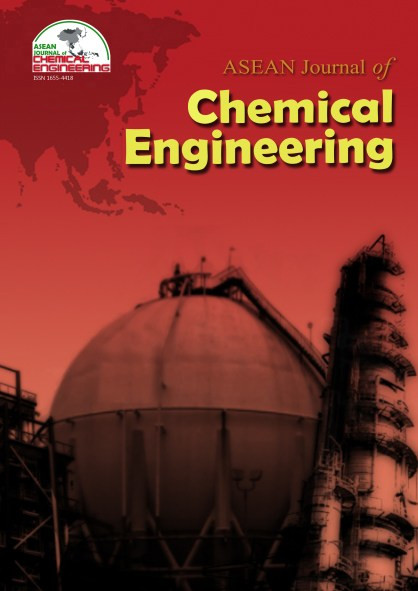Zeolite Effect on Solid Product Characteristics in Hydrothermal Treatment of Household Waste
Abstract
The number of primary energy sources in Indonesia will run out quickly. Therefore, innovation is required to provide renewable energy sources (NRE) that accommodate the increasing energy necessities. Hydrothermal is the potential degradation process of plastic waste to generate NRE. This study aims to examine the effectiveness of the hydrothermal process in breaking down bulky raw materials and the role of zeolite as a catalyst to upgrade the quality of hydrochar as a novel solid fuel by evaluating the essential parameters through proximate and ultimate analysis. The addition of zeolite in the hydrothermal process can increase the water content, ash content, and volatile matter and slightly decrease the calorific value and fixed carbon. The condition to obtain the best characteristics was temperature of 220 oC and the addition of 20 % zeolite.
References
Abidin, A., Purnomo, C.W., Cahyono, R.B., 2018. "Hydro-char Production from Press-mud Wastes of the Sugarcane Industry by Hydrothermal Treatment with Natural Zeolite Addition." AIP Conf. Proc., 2026 (1), 020049.
Chamas, A., Moon, H., Zheng, J., Qiu, Y., Tabassum, T., Jang, J. H., Abu-omar, M., Scott, S. L., & Suh, S., 2020. "Degradation Rates of Plastics in the Environment". ACS Sustainable Chem. Eng., 8 (9), 3494–3511.
Chattopadhyay, J., Pathak, T. S., Srivastava, R., & Singh, A. C., 2016. "Catalytic co-pyrolysis of paper biomass and plastic mixtures (HDPE (high density polyethylene), PP (polypropylene) and PET (polyethylene terephthalate)) and product analysis." Energy, 103, 513–521.
Cheng, F., Tompsett, G.A., Murphy, C.M., Maag, A.R., Carabillo, N., Bailey, M., Hemingway, J.J., Romo, C.I., Paulsen, A.D., Yelvington, P.E., Timko, M.T., 2020."Synergistic Effects of Inexpensive Mixed Metal Oxides for Catalytic Hydrothermal Liquefaction of Food Wastes." ACS Sustainable Chem. Eng, 8, 6877-6886.
Govindasamy, G., Kumar, P.J., 2022. "Hydrothermal Liquefaction of Food Waste to Bio-oil over Hierarchical Fe-Co-ZSM-5 Catalyst for the Circular Economy." Material Today: Proceedings, 65, 3688-3693.
Hao, B., Xu, D., Wang, Y., Wang, Y., Kapusta, K., Guo, Y., 2023. "Catalytic Hydrothermal Liquefaction of Municipal Sludge for Biocrude Production over Non-noble Bimetallic Catalyst in Ethanol Solvent." Fuel, 331, 125812.
Hrnčič, M. K., Kravanja, G., Knez, Z. 2016. "Hydrothermal treatment of biomass for energy and chemicals." Energy, 116(2), 1312-1322.
Kalapathy, U., 2002. "An improved method for production of silica from rice hull ash." Bioresource Technology, 85(3), 285-9.
Kammann, C., & Funke, A., 2017. "Hydrothermal carbonization of biomass residuals: A comparative review of the chemistry, processes and applications of wt and dry pyrolysis." Biofuels, 2 (1), 71-106.
Kusdarto., 2008. "Potensi Zeolit di Indonesia." Journal of Indonesia Zeolites, 7 (2), 78-87
Lahijani, P., & Zainal, Z. A., 2011. "Gasification of palm empty fruit bunch in a bubbling fluidized bed: A performance and agglomeration study." Bioresource Technology, 102(2), 2068–2076.
Mckendry, P., 2002. Energy production from biomass (part 1): overview of biomass. Bioresource Technology, 83(1), 37–46.
Mukundan, S., Wagner, J.L., Annamalai, P.K., Ravindran, D.S., Krishnapillai, G.K., Beltramini, J., 2022. "Hydrothermal Co-liquefaction of Biomass and Plastic Wastes into Biofuel: Study on Catalyst Property, Product Distribution and Synergistic Effects." Fuel Processing Technology, 238, 107523.
Nurdiawati, A., Novianti, S., Zaini, I. N., Nakhshinieva, B., Sumida, H., Takahashi, F., & Yoshikawa, K., 2015. "Evaluation of hydrothermal treatment of empty fruit bunch for solid fuel and liquid organic fertilizer co-production." Energy Procedia, 79, 226-232.
Román, S., Nabais, J. M. V., Laginhas, C., Ledesma, B., & González, J. F., 2012 "Hydrothermal carbonization as an effective way of densifying the energy content of biomass." Fuel Processing Technology, 103, 78–83.
Saddawi, A., Jones, J. M., Williams, A., & Coeur, C. Le., 2012. "Commodity Fuels from biomass through pretreatment and torrefaction : effects of mineral content on torrefied fuel charac-teristics and quality." Energy Fuels, 26(11), 6466-6474.
Maleiva, L. T. N., Purnomo, C. W., 2020 "Solid waste co-conversion by hydrothermal treatment using natural zeolite." Makara Journal of Science, 24(3), 148−153.
Yuliansyah, A.T., T. Hirajima, S. Kumagai, K. Sasaki, 2010. "Production of solid biofuel from agricultural wastes of the palm oil industry by hydrothermal treatment production of solid biofuel from agricultural wastes of the palm oil industry by hydrothermal treatment." Waste and Biomass Valorization, 1, 395-405.
Zhang, L., Charles, C., & Champagne, P., 2010. "Overview of recent advances in thermo-chemical conversion of biomass." Energy Conversion and Management, 51(5), 969–982.
Zhang, W., Han, X., Liu, X., & Bao, X., 2003. "Characterization of the acid sites in dealuminated nanosized HZSM-5 zeolite with the probe molecule trimethylphosphine." Journal of Molecular Catalysis A: Chemical, 194(1–2), 107–113.
Copyright holder for articles is ASEAN Journal of Chemical Engineering. Articles published in ASEAN J. Chem. Eng. are distributed under a Creative Commons Attribution-NonCommercial 4.0 International (CC BY-NC 4.0) license.
Authors agree to transfer all copyright rights in and to the above work to the ASEAN Journal of Chemical Engineering Editorial Board so that the Editorial Board shall have the right to publish the work for non-profit use in any media or form. In return, authors retain: (1) all proprietary rights other than copyright; (2) re-use of all or part of the above paper in their other work; (3) right to reproduce or authorize others to reproduce the above paper for authors’ personal use or for company use if the source and the journal copyright notice is indicated, and if the reproduction is not made for the purpose of sale.



